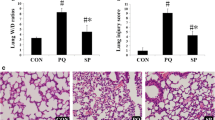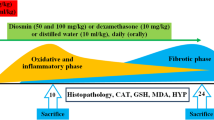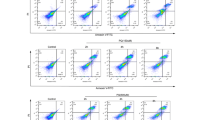Abstract
Objectives
Paraquat (PQ) is a widely used herbicide. Exposure to PQ at toxic doses can result in fatal acute lung injury. Inhibition of the poly-(ADP-ribose) polymerase (PARP) enzyme alleviates inflammation and necrosis in various pathologies. Here we aimed to evaluate the effects of PARP inhibition on PQ-induced lung damage in a rat experimental model.
Methods
Female Sprague-Dawley rats (n = 24) were allocated into three groups: sham, PQ and PQ + 3-aminobenzamide (3-AB) that is a PARP inhibitor, groups. Experimental lung injury was induced by administration of 15 mg/kg PQ intraperitoneally in PQ and PQ + 3-AB groups. 3-AB (10 mg/kg twice per day) was administered to the PQ + 3-AB group for four consecutive days. The animals were killed on the fifth day following PQ administration. Lung tissue and blood samples were collected and stored until analysis.
Results
Serum lactate dehydrogenase (LDH) and neopterin levels, tissue oxidative stress parameters, transforming growth factor-beta1 (TGF-β) levels and histological injury scores in the PQ + 3-AB group were significantly lower than in the PQ group (P < 0.05, PQ vs. PQ + 3-AB). Total antioxidant capacity in the PQ + 3-AB group was significantly higher than in the PQ group (P < 0.05, PQ + 3-AB vs. PQ).
Conclusion
Our results suggested that the use of PARP inhibitors following PQ toxicity might be useful for minimizing lung injury due to paraquat toxicity.

Similar content being viewed by others
References
Alrashed M, Abougoush M, Akgul EO et al (2002) Detection method of serum and urine neopterin levels by high performance liquid chromatography and clinical applications. Gulhane MJ 44:273–277
Bühling F, Thölert G, Kaiser D et al (1999) Increased release of transforming growth factor (TGF)-beta1, TGF-beta2, and chemoattractant mediators in pneumonia. J Interferon Cytokine Res 19(3):271–278
Cuzzocrea S, McDonald MC, Mazzon E et al (2002) Effects of 5-aminoisoquinolinone, a water-soluble, potent inhibitor of the activity of poly(ADP-ribose) polymerase, in a rodent model of lung injury. Biochem Pharmacol 63:293–304
Cuzzocrea S (2005) Shock, inflammation and PARP. Pharmacol Res 52(1):72–82
Celik SE, Ozyurek M, Guclu K et al (2012) Differences in responsivity of original cupric reducing antioxidant capacity and cupric-bathocuproine sulfonate assays to antioxidant compounds. Anal Biochem 423(1):36–38
Drent M, Cobben NA, Henderson RF et al (1996) Usefulness of lactate dehydrogenase and its isoenzymes as indicators of lung damage or inflammation. Eur Respir J 9(8):1736–1742
Durak I, Yurtarslanl Z, Canbolat O et al (1993) A methodological approach to superoxide dismutase (SOD) activity assay based on inhibition of nitroblue tetrazolium (NBT) reduction. Clin Chim Acta 214(1):103–104
Gebhard C, Stähli BE, Shi Y et al (2011) Poly(ADP-ribose) polymerase-1 protects from oxidative stress induced endothelial dysfunction. Biochem Biophys Res Commun 414(4):641–646
Gocgeldi E, Uysal B, Korkmaz A et al (2008) Establishing the use of melatonin as an adjuvant therapeutic against paraquat-induced lung toxicity in rats. Exp Biol Med (Maywood) 233(9):1133–1141
Kao SJ, Liu DD, Su CF et al (2007) Niacinamide abrogates the organ dysfunction and acute lung injury caused by endotoxin. J Cardiovasc Pharmacol 50(3):333–342
Kaufmann P, Tilz GP, Demel U et al (1998) Neopterin plasma concentrations predict the course of severe acute pancreatitis. Clin Chem Lab Med 36:29–34
Kiefmann R, Heckel K, Doerger M et al (2004) Role of PARP on iNOS pathway during endotoxin-induced acute lung injury. Intensive Care Med 30(7):1421–1431
Koksel O, Yildirim C, Cinel L et al (2005) Inhibition of poly(ADP-ribose) polymerase attenuates lung tissue damage after hind limb ischemia-reperfusion in rats. Pharmacol Res 51(5):453–462
Liaudet L, Pacher P, Mabley JG et al (2002) Activation of poly(ADP-Ribose) polymerase-1 is a central mechanism of lipopolysaccharide-induced acute lung inflammation. Am J Respir Crit Care Med 165(3):372–377
Lindahl T, Satoh MS, Poirier GG, Klungland (1995) Post-translational modification of poly(ADP-ribose) polymerase induced by DNA strand breaks. Trends Biochem Sci 20(10):405–411
Lowry OH, Rosebrough NJ, Farr AL et al (1951) Protein measurement with the Folin phenol reagent. J Biol Chem 193(1):265–275
Morán JM, Ortiz-Ortiz MA, Ruiz-Mesa LM et al (2010) Nitric oxide in paraquat mediated toxicity: a review. J Biochem Mol Toxicol 24(6):402–409
Murakami K, Enkhbaatar P, Shimoda K et al (2004) Inhibition of poly(ADP-ribose) polymerase attenuates acute lung injury in an ovine model of sepsis. Shock 21:126–133
Naziroglu M (2007) New molecular mechanisms on the activation of TRPM2 channels by oxidative stress and ADP-ribose. Neurochem Res 32:1990–2001
Ohkawa H, Ohishi N, Yagi K (1979) Assay for lipid peroxides in animal tissues by thiobarbituric acid reaction. Anal Biochem 95:351–358
Paglia DE, Valentine WN (1967) Studies on the quantitative and qualitative characterization of erythrocyte glutathione peroxidase. J Lab Clin Med 70:158–169
Suntres ZA (2000) Role of antioxidants in paraquat toxicity. Toxicology 180:65–77
Szabo C, Zingarelli B, O’Connor M et al (1996) DNA strand breakage, activation of poly (ADP-ribose) synthetase, and cellular energy depletion are involved in the cytotoxicity of macrophages and smooth muscle cells exposed to peroxynitrite. Proc Natl Acad Sci USA 93:1753–1758
Tylman M, Bengtson JP, Hyllner M et al (2006) Release of PMN elastase, TGF-beta1 and neopterin during blood storage; unfiltered versus filtered blood. Transfus Apher Sci 35(2):97–102
Virag L, Szabo E, Bakondi E et al (2002) Nitric oxide-peroxynitrite-poly(ADP-ribose) polymerase pathway in the skin. Exp Dermatol 11:189–202
Yamanel L, Kaldirim U, Oztas Y et al (2011) Ozone therapy and hyperbaric oxygen treatment in lung injury in septic rats. Int J Med Sci. 3 8(1):48–55
Author information
Authors and Affiliations
Corresponding author
Ethics declarations
Conflict of interest
The authors report no declarations of interest. We have not been funded by any individual or organization.
Rights and permissions
About this article
Cite this article
Tuncer, S.K., Altinel, S., Toygar, M. et al. Poly-ADP-ribose polymerase inhibition provides protection against lung injury in a rat paraquat toxicity model. Inflammopharmacol 24, 155–161 (2016). https://doi.org/10.1007/s10787-016-0268-1
Received:
Accepted:
Published:
Issue Date:
DOI: https://doi.org/10.1007/s10787-016-0268-1




